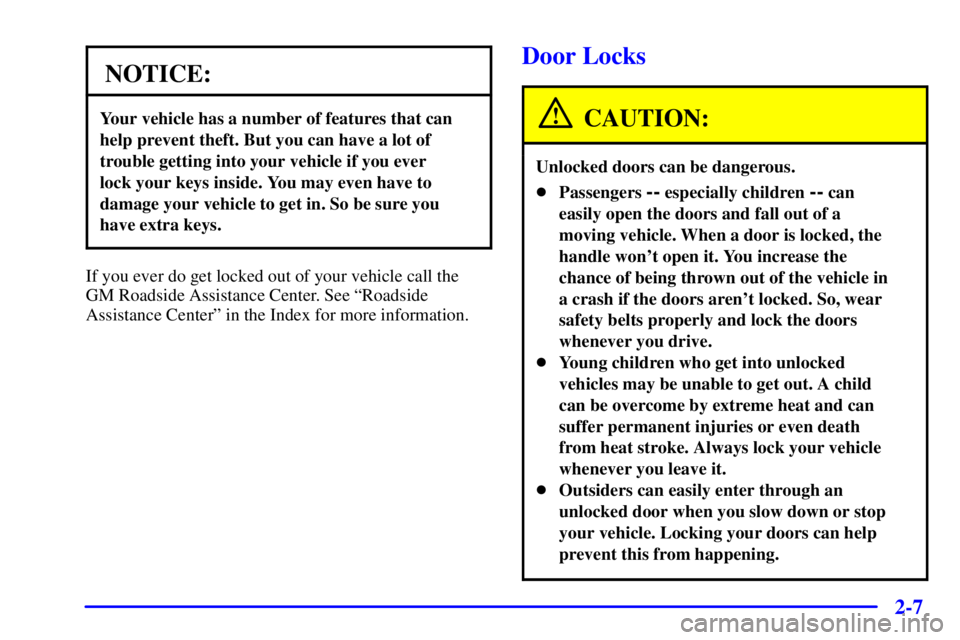Page 4 of 407
Table of Contents
Windows
Keys and Door Locks
Remote Keyless Entry (If Equipped)
Tailgate
Automatic Transmission (If Equipped)
Manual Transmission Operation (If Equipped)
Four-Wheel Drive (If Equipped)
Parking Brake
Tilt Wheel (If Equipped)Turn Signal/Multifunction Lever
Windshield Wipers
Cruise Control (If Equipped)
Exterior and Interior Lamps
Mirrors
Storage Compartments
Accessory Power Outlets
OnStar
® System (If Equipped)
Instrument Panel, Warning Lights and Gages Seats and Seat Controls
Safety BeltsAir Bag Systems
Restraint Systems for Children
Section
1
Section
2
Seats and Restraint Systems
Features and Controls
ii
Page 11 of 407

ix
For example,
these symbols
are used on an
original battery:
CAUTION
POSSIBLE
INJURY
PROTECT
EYES BY
SHIELDING
CAUSTIC
BATTERY
ACID COULD
CAUSE
BURNS
AVOID
SPARKS OR
FLAMES
SPARK OR
FLAME
COULD
EXPLODE
BATTERY
These symbols
are important for
you and your
passengers
whenever your
vehicle is driven:
CHILD
RESTRAINT
TOP STRAP
ANCHOR
DOOR LOCK
UNLOCK
FASTEN
SEAT
BELTS
POWER
WINDOW
AIR BAG
These symbols
have to do with
your lamps:
MASTER
LIGHTING
SWITCH
TURN
SIGNALS
PARKING
LAMPS
HAZARD
WARNING
FLASHER
DAYTIME
RUNNING
LAMPS
FOG LAMPS
These symbols
are on some of
your controls:
WINDSHIELD
WIPER
WINDSHIELD
WASHER
WINDSHIELD
DEFROSTER
REAR
WINDOW
DEFOGGER
VENTILATING
FAN
These symbols
are used on
warning and
indicator lights:
ENGINE
COOLANT
TEMP
BATTERY
CHARGING
SYSTEM
BRAKE
COOLANT
ENGINE OIL
PRESSURE
ANTI-LOCK
BRAKES
Here are some
other symbols
you may see:
FUSE
LIGHTER
HORN
FUEL
Vehicle Symbols
These are some of the symbols you may find on your vehicle. Also see ªWarning Lights and Gagesº in the Index.
Page 25 of 407

1-12
Q:If I'm a good driver, and I never drive far from
home, why should I wear safety belts?
A:You may be an excellent driver, but if you're in an
accident
-- even one that isn't your fault -- you and
your passengers can be hurt. Being a good driver
doesn't protect you from things beyond your
control, such as bad drivers.
Most accidents occur within 25 miles (40 km)
of home. And the greatest number of serious
injuries and deaths occur at speeds of less
than 40 mph (65 km/h).
Safety belts are for everyone.
How to Wear Safety Belts Properly
Adults
This part is only for people of adult size.
Be aware that there are special things to know
about safety belts and children. And there are different
rules for smaller children and babies. If a child will
be riding in your vehicle, see the part of this manual
called ªChildren.º Follow those rules for
everyone's protection.
First, you'll want to know which restraint systems your
vehicle has.
We'll start with the driver position.
Driver Position
This part describes the driver's restraint system.
Lap-Shoulder Belt
The driver has a lap-shoulder belt. Here's how to wear
it properly.
1. Close and lock the door.
2. Adjust the seat so you can sit up straight. To see
how, see ªSeatsº in the Index.
Page 72 of 407

2-
2-1
Section 2 Features and Controls
Here you can learn about the many standard and optional features on your vehicle, and information on starting,
shifting and braking. Also explained are the instrument panel and the warning systems that tell you if everything
is working properly
-- and what to do if you have a problem.
2
-2 Windows
2
-5 Keys
2
-7 Door Locks
2
-10 Remote Keyless Entry System (If Equipped)
2
-14 Tailgate
2
-15 Theft
2
-16 Content Theft-Deterrent (If Equipped)
2
-18 Passlock�
2-18 New Vehicle ªBreak-Inº
2
-19 Ignition Positions
2
-21 Starting Your Engine
2
-23 Engine Coolant Heater (If Equipped)
2
-24 Automatic Transmission Operation
2
-27 Manual Transmission Operation
2
-29 Four-Wheel Drive (If Equipped)
2
-32 Parking Brake
2
-33 Shifting Into PARK (P)
(Automatic Transmission Only)2
-35 Shifting Out of PARK (P)
(Automatic Transmission Only)
2
-36 Parking Over Things That Burn
2
-37 Engine Exhaust
2
-37 Running Your Engine While You're Parked
(Automatic Transmission)
2
-38 Locking Rear Axle
2
-38 Tilt Wheel (If Equipped)
2
-39 Turn Signal/Multifunction Lever
2
-45 Exterior Lamps
2
-48 Interior Lamps
2
-50 Mirrors
2
-53 Storage Compartments
2
-61 Accessory Power Outlets (If Equipped)
2
-65 Instrument Panel - Your Information System
2
-66 Instrument Panel Cluster
2
-69 Warning Lights, Gages and Indicators
Page 75 of 407
2-4
Express-Down Window
The driver's window switch also has an express
-down
feature that allows you to lower the window without
holding the window switch. Press the driver's window
switch down briefly to activate the express
-down
feature. Lightly tap the switch to open the window
slightly. The express
-down feature can be interrupted at
any time by pressing the up arrow end of the switch.
Lockout Switch (Crew Cab)
Four
-door vehicles have a lockout feature to prevent
passengers from operating the power windows. It is
located on the driver's door armrest. Press LOCK to
activate this feature. Press NORM and the windows will
return to normal operation.
Swing-Out Windows (Extended Cab)
To open a rear swing-out
window, pull the latch
toward the front of the
vehicle and then push the
latch out and rearward.
When you close the window, be sure the latch engages.
Page 77 of 407
2-6
This vehicle has one
double
-sided key for the
ignition and door locks. It
will fit with either side up.
When a new vehicle is delivered, the dealer provides
the owner with a pair of identical keys and a key
code number.
The key code number tells your dealer or a qualified
locksmith how to make extra keys. Keep this number in
a safe place. If you lose your keys, you'll be able to have
new ones made easily using this number. Your dealer
should also have this number.
Page 78 of 407

2-7
NOTICE:
Your vehicle has a number of features that can
help prevent theft. But you can have a lot of
trouble getting into your vehicle if you ever
lock your keys inside. You may even have to
damage your vehicle to get in. So be sure you
have extra keys.
If you ever do get locked out of your vehicle call the
GM Roadside Assistance Center. See ªRoadside
Assistance Centerº in the Index for more information.
Door Locks
CAUTION:
Unlocked doors can be dangerous.
�Passengers -- especially children -- can
easily open the doors and fall out of a
moving vehicle. When a door is locked, the
handle won't open it. You increase the
chance of being thrown out of the vehicle in
a crash if the doors aren't locked. So, wear
safety belts properly and lock the doors
whenever you drive.
�Young children who get into unlocked
vehicles may be unable to get out. A child
can be overcome by extreme heat and can
suffer permanent injuries or even death
from heat stroke. Always lock your vehicle
whenever you leave it.
�Outsiders can easily enter through an
unlocked door when you slow down or stop
your vehicle. Locking your doors can help
prevent this from happening.
Page 79 of 407
2-8
There are several ways to lock and unlock your vehicle.
You can use the keyless entry system, if you have this
feature. You can also use your key to unlock your door
from the outside. To lock your door from the inside,
slide the lever on the inside of the door down.
To unlock the door, slide the
lever on the inside of the
door up. You will see a red
area on the lever.
You can also use the power door lock
switch (if equipped).
Power Door Locks (If Equipped)
If your vehicle has power door locks, the switch is
located on the armrest. Remove the ignition key and
press LOCK to lock all the doors at once.
To unlock the doors, press the raised area next to the
key symbol.